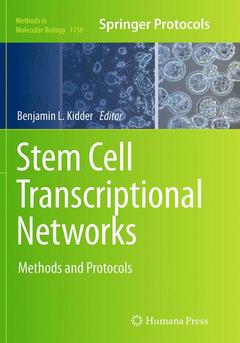Description
Stem Cell Transcriptional Networks, Softcover reprint of the original 1st ed. 2014
Methods and Protocols
Methods in Molecular Biology Series, Vol. 1150
Coordinator: Kidder Benjamin L.
Language: English
Subjects for Stem Cell Transcriptional Networks:
Support: Print on demand
286 p. · 17.8x25.4 cm · Hardback
Description
/li>Contents
/li>Comment
/li>
Stem Cell Transcriptional Networks: Methods and Protocols collects techniques used to increase our understanding of the underlying transcriptional programs of stem cells that promote self-renewal and differentiation. The volume opens with a section on next-generation sequencing library preparation and data analysis. Continuing with a collection of protocols on visual analysis and interpretation of large-scale interaction networks, this detailed compilation features transcriptional networks in embryonic and adult stem cells, embryo culture and derivation of stem cells, as well as transcriptional programs that promote self-renewal, reprogramming, and transdifferentiation. Written for the highly successful Methods in Molecular Biology series, chapters include introductions to their respective topics, lists of the necessary materials, step-by-step, readily reproducible protocols and tips on troubleshooting and avoiding known pitfalls.
Authoritative and practical, Stem Cell Transcriptional Networks: Methods and Protocols aims to provide a key resource for biologists seeking to interrogate these vital networks.
Efficient Library Preparation for Next-Generation Sequencing Analysis of Genome-Wide Epigenetic and Transcriptional Landscapes in Embryonic Stem Cells.- Analysis of Next-Generation Sequencing Data Using Galaxy.- edgeR for Differential RNA-seq and ChIP-seq Analysis: An Application to Stem Cell Biology.- Use Model-based Analysis of ChIP-Seq (MACS) to Analyze Short Reads Generated by Sequencing Protein-DNA Interactions in Embryonic Stem Cells.- Spatial Clustering for Identification of ChIP-Enriched Regions (SICER) to Map Regions of Histone Methylation Patterns in Embryonic Stem Cells.- Identifying Stem Cell Gene Expression Patterns and Phenotypic Networks with AutoSOME.- Visualization and Clustering of High-Dimensional Transcriptome Data Using GATE.- Interpreting and Visualizing ChIP-seq Data with the seqMINER Software.- A Description of the Molecular Signatures Database (MSigDB) Website.- Use of Genome-Wide RNAi Screens to Identify Regulators of Embryonic Stem Cell Self-Renewal and Pluripotency.- Correlating Histone Modification Patterns with Gene Expression Data During Hematopoiesis.- In Vitro Maturation and In Vitro Fertilization of Mouse Oocytes and Preimplantation Embryo Culture.- Derivation and Manipulation of Trophoblast Stem Cells from Mouse Blastocysts.- Conversion of Epiblast Stem Cells to Embryonic Stem Cells Using Growth Factors and Small Molecule Inhibitors.- Generation of Induced Pluripotent Stem Cells Using Chemical Inhibition and Three Transcription Factors.- Transdifferentiation of Mouse Fibroblasts and Hepatocytes to Functional Neurons.- Direct Lineage Conversion of Pancreatic Exocrine to Endocrine Beta-Cells In Vivo with Defined Factors.- Direct Reprogramming of Cardiac Fibroblasts to Cardiomyocytes Using MicroRNAs.- Reprogramming Somatic Cells into Pluripotent Stem Cells Using miRNAs.
These books may interest you

Regulatory Networks in Stem Cells 231.05 €



